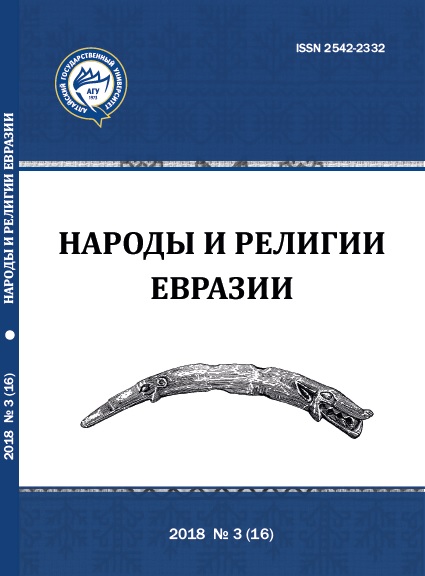Islam of the Khakasia (in the context of the idea of “all turks are muslims”)
Main Article Content
Abstract
The aim of this paper is to study the history of the spread of Islam in Khakassia. It has not been thoroughly researched. All this causes various pseudoscientific views sometimes politicized. There is a disregard for historical facts, or their interpretation, based on a narrow-minded conjectures. This region became the dominant religion, Islam has not in the past. Is not dominant, and in the 21st century.
Even during the early Middle Ages the Muslims of the Middle East on the basis of Quranic beliefs and disparate information perception about fearsome tribes jadzhudzhi and madzhudzhi living "on the edge of the world" in North Asia. Over time, the idea of Muslims living there reign expanded, but perceived them. The situation changed when the part of the Turkish elite appeared (and still exists) the idea of unification of Muslims into an independent political entity, where the idea of "great Turkistan (great Turan) is based on three "pillars": tjurkizacii, Islamization and modernization, implying that all Turks are Muslims.
The view is definitely wrong. In this regard, is the fate of the Islamic religion and its followers in one of the Eastern constituent entities of the Russian Federation-Republic of khakasia, where Khakas (tadarlar/minusinskie, abakanskie, achinskie Tatars/yenisei Kirghiz) were long tengrism, but in the 19th century forcibly converted to orthodoxy.
The authos use a variety of sources. They come to the conclusion that at the present stage formed local institutions of the Umma. At the same time transforming religious and ethno-cultural identity. Offers recommendations to prevent extremism.
Downloads
Metrics
Article Details
References
Байпаков К. М. Распространение ислама в Южном Казахстане и Семиречье // Ислам, общество и культура : материалы Международной научной конференции «Исламская цивилизация в преддверии XXI в. (к 600-летию ислама в Сибири)». Омск, 1994. С. 16-17.
Бустанов А. К. Книжная культура сибирских мусульман. М. : Изд. дом Марджани, 2013. 264 с.
Гольденберг Л. А. Изограф земли сибирской: жизнь и труды Семена Ремезова. Магадан : Магаданское кн. изд-во, 1990. 391 с.
Дульзон А. П. Тюрки Чулыма и их отношение к хакасам // Учёные записки Хакасского научно-исследовательского института языка, литературы, истории. Вып. VII. Абакан : Хакасское кн. изд-во, 1959. С. 93-102.
Евтюхова Л. А., Киселев С. В. Чаа-Тас у села Копены // Труды Государственного исторического музея : сборник статей по археологии СССР. Вып. 11. М., 1940. С. 21-54.
Катанов Н. Ф. О религиозных войнах учеников шейха Багауддина против иноземцев Западной Сибири // Ежегодник Тобольского губернского музея. Вып. 15. Тобольск, 1904. С. 3-28.
Копелев Л. З. Чужие // Одиссей. Человек в истории. Образ «другого» в культуре. М., 1994. С. 8-18. Коран, 2:256.
Кызласов Л. Р. Торговые пути и связи древнехакасского государства с Западной Сибирью и Восточной Европой // Западная Сибирь в эпоху Средневековья : сборник статей. Томск, 1984.
Насруллаев Джунайдулло [Электронный ресурс]. URL: http://dumrf.ru/common/bi-ographies/2519 (дата обращения: 28.06.2018).
Самушкина Е. В. Символические и социо-нормативные аспекты современного этно-политического движения Республик Алтай, Тыва, Хакасия. Новосибирск : Изд-во ИАЭТ СО РАН, 2009. 274 с.
Супруненко Г. П. Документы об отношениях Китая с енисейскими киргизами в источнике IX в. «Ли Вэй-гун Хойчан Ипинь Цзи» (Собрание сочинений Ли Вэй-гуна периода правления Хойчан, 841-846 гг.) [Электронный ресурс]. URL: http://www.kyrgyz.ru/articles/khakas/gpsuprunenkodokumenty_ob_otnosheniyah_kita-ya_s_eniseyskimi_kyrgyzami_v_istochnike_ix_veka_li_vey-gun_hoychan_ipin_tszi/ (дата обращения: 28.06.2018).
Томилов Н. А. Тюркоязычное население Западно-Сибирской равнины в конце XVI — первой четверти XIX в. Томск : Изд-во Томского гос. ун-та, 1981. 276 с.
Шульженко Н. В. Исламский фактор в социальных процессах на Дальнем Востоке России : дис. . канд. соц. наук. Хабаровск, 2009. 196 с.

